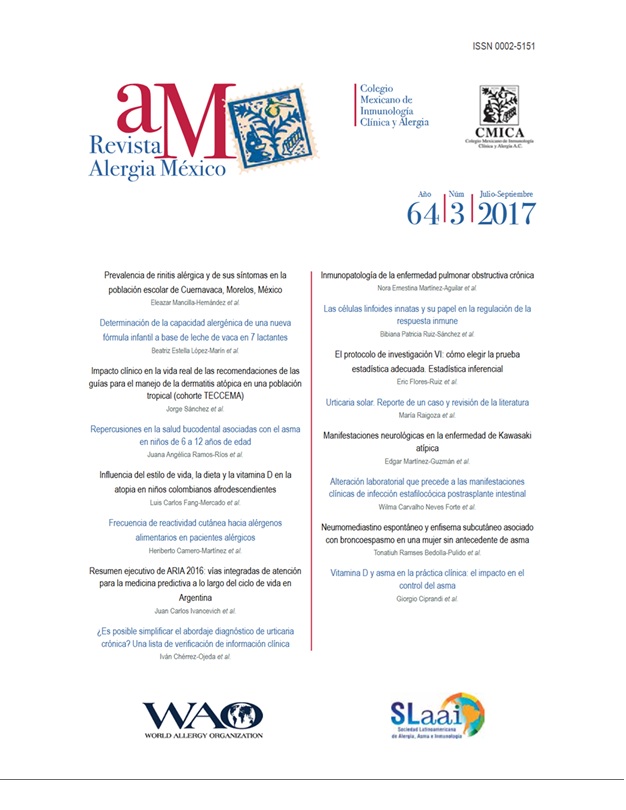Resumen
Antecedentes: Se ha estudiado poco el impacto en la vida real de las guías de manejo de la dermatitis atópica.
Objetivo: Evaluar el control clínico de la dermatitis atópica en residentes de un área tropical manejados conforme a los consensos internacionales.
Métodos: Estudio prospectivo con seguimiento por 24 meses. La respuesta clínica fue evaluada mediante SCORAD, DLQI y una escala subjetiva (SS) de la percepción de severidad del paciente.
Resultados: 233 pacientes fueron estratificados conforme el SCORAD: gravedad leve 53 (22 %), moderada 116 (49 %) y severa 64 (27 %). La media inicial del SCORAD fue de 33 (15-41), del DLQI de 14 (11-20) y de la escala subjetiva de 85 % (67-99). A los 6 meses existió reducción significativa (p < 0.5): SCORAD 29 (14-41), DLQI 12 (8-16) y escala subjetiva 62 % (45-80). A los 2 años, SCORAD (21, 9-34), DLQI (7, 4-10) y escala subjetiva (41 %, 27-56); solo 33 % consiguió control completo (SCORAD < 15 %, DLQI < 5, escala subjetiva < 20 %).
Conclusiones: El apego a las guías internacionales reduce la gravedad del eccema y mejora de forma importante la calidad de vida de los pacientes con dermatitis. Sin embargo, solo 33 % de los pacientes alcanza un control completo a los 2 años de seguir las recomendaciones.
Referencias
Genuneit J, Braig S, Brandt S, Wabitsch M, Florath I, Brenner H, et al. Infant atopic eczema and subsequent attention-deficit/hyperactivity disorder. A prospective birth cohort study. Pediatr Allergy Immunol. 2014;25(1):51-56. DOI: http://dx.doi.org/10.1111/pai.12152
Simpson EL. Comorbidity in atopic dermatitis. Curr Dermatol Rep. 2012;1(1):29-38. Disponible en: https://www.ncbi.nlm.nih.gov/pmc/articles/PMC3671606/
Sánchez J, Páez B, Macías A, Olmos C, De Falco A. Puntos clave en el tratamiento de la dermatitis en Latinoamérica. El consenso SLAAI. Rev Alerg Mex. 2014;61(3):178-211. Disponible en: http://revistaalergia.mx/ojs/index.php/ram/article/view/87
Ring J, Alomar A, Bieber T, Deleuran M, Fink-Wagner A, Gelmetti C, et al. Guidelines for treatment of atopic eczema (atopic dermatitis). Part I. J Eur Acad Dermatol Venereol. 2012;26(8):1045-1060. DOI: http://dx.doi.org/10.1111/j.1468-3083.2012.04635.x
Darsow U, Wollenberg A, Simon D, Taïeb A, Werfel T, Oranje A, et al. ETFAD/EADV eczema task force 2009 position paper on diagnosis and treatment of atopic dermatitis. J Eur Acad Dermatol Venereol. 2010;24(3):317-328. DOI: http://dx.doi.org/10.1111/j.1468-3083.2009.03415.x
Lopez N, de Barros-Mazon S, Vilela MM, Condino Neto A, Ribeiro JD. Are immunoglobulin E levels associated with early wheezing? A prospective study in Brazilian infants. Eur Respir J. 2002;20(3):640-645. DOI: http://dx.doi.org/10.1183/09031936.02.00219302
Rullo VE, Arruda LK, Cardoso MR, Valente V, Zampolo AS, Nóbrega F, et al. Respiratory infection, exposure to mouse allergen and breastfeeding: Role in recurrent wheezing in early life. Int Arch Allergy Immunol. 2009;150(2):172-178. DOI: http://dx.doi.org/10.1159/000218120.
Cooper PJ, Chico ME, Guadalupe I, Sandoval CA, Mitre E, Platts-Mills TA, et al. Impact of early life exposures to geohelminth infections on the development of vaccine immunity, allergic sensitization, and allergic inflammatory diseases in children living in tropical Ecuador: the ECUAVIDA birth cohort study. BMC Infect Dis. 2011;11:184. DOI: http://dx.doi.org/10.1186/1471-2334-11-184.
Acevedo N, Sánchez J, Zakzuk J, Bornacelly A, Quiróz C, Alvarez A, et al. Particular characteristics of allergic symptoms in tropical environments: Follow up to 24 months in the FRAAT birth cohort study. BMC Pulm Med. 2012;12:13. DOI: http://dx.doi.org/10.1186/1471-2466-12-13.
Dennis RJ, Caraballo L, García E, Rojas MX, Rondon MA, Pérez A, et al. Prevalence of asthma and other allergic conditions in Colombia 2009-2010: a cross-sectional study. BMC Pulm Med. 2012;12:17. DOI: http://dx.doi.org/10.1186/1471-2466-12-17.
Sánchez J, Diez S, Cardona R. Frecuencia de sensibilización a animales en un área tropical. Rev Alerg Mex. 2014;61(2):81-89. Disponible en: http://revistaalergia.mx/ojs/index.php/ram/article/view/30
Sánchez J, Sánchez A. Epidemiology of food allergy in Latin America. Allergol Immunopathol (Madr). 2015;43(2):185-195. DOI: http://dx.doi.org/10.1016/j.aller.2013.07.001.
Sanchez J, Diez S, Cardona R. Sensibilización a aeroalergenos en pacientes alérgicos de Medellín, Colombia. Rev Alerg Mex. 2012;59(3):139-147.
Ruiz-Linares A, Adhikari K, Acuña-Alonzo V, Quinto-Sánchez M, Jaramillo C, Arias W, et al. Admixture in Latin America: Geographic structure, phenotypic diversity and self-perception of ancestry based on 7,342 individuals. PLoS Genet. 2014;10(9):e1004572. DOI: http://dx.doi.org/10.1371/journal.pgen.1004572.
Wang S, Ray N, Rojas W, Parra MV, Bedoya G, Gallo C, et al. Geographic patterns of genome admixture in Latin American Mestizos. PLoS Genet. 2008;4(3):e1000037. DOI: http://dx.doi.org/10.1371/journal.pgen.1000037.
Hanifin JM. Diagnostic criteria for atopic dermatitis: Consider the context. Arch Dermatol. 1999;135(12):1551.
Heinzerling LM, Burbach GJ, Edenharter G, Bachert C, Bindslev-Jensen C, Bonini S, et al. GA(2)LEN skin test study I: GA(2)LEN harmonization of skin prick testing: novel sensitization patterns for inhalant allergens in Europe. Allergy. 2009;64(10):1498-1506. DOI: http://dx.doi.org/10.1111/j.1398-9995.2009.02093.x.
Sánchez-Caraballo JM, Cardona-Villa R. Clinical and immunological changes of immunotherapy in patients with atopic dermatitis: Randomized controlled trial. ISRN Allergy. 2012;2012:183983. DOI: http://dx.doi.org/10.5402/2012/183983.
Beck LA, Thaçi D, Hamilton JD, Graham NM, Bieber T, Rocklin R, et al. Dupilumab treatment in adults with moderate-to-severe atopic dermatitis. N Engl J Med. 2014;371(2):130-139. DOI: http://dx.doi.org/10.1056/NEJMoa1314768.
Hamilton JD, Suárez-Fariñas M, Dhingra N, Cardinale I, Li X, Kostic A, et al. Dupilumab improves the molecular signature in skin of patients with moderate-to-severe atopic dermatitis. J Allergy Clin Immunol. 2014;134(6):1293-1300. DOI: http://dx.doi.org/10.1016/j.jaci.2014.10.013.
Ohsawa Y, Hirasawa N. The role of histamine H1 and H4 receptors in atopic dermatitis: from basic research to clinical study. Allergol Int. 2014;63(4):533-542. DOI: http://dx.doi.org/10.2332/allergolint.13-RA-0675.
Gschwandtner M, Mildner M, Mlitz V, Gruber F, Eckhart L, Werfel T, et al. Histamine suppresses epidermal keratinocyte differentiation and impairs skin barrier function in a human skin model. Allergy. 2013;68(1):37-47. DOI: http://dx.doi.org/10.1111/all.12051.
Dunford PJ, Williams KN, Desai PJ, Karlsson L, McQueen D, Thurmond RL. Histamine H4 receptor antagonists are superior to traditional antihistamines in the attenuation of experimental pruritus. J Allergy Clin Immunol. 2007;119(1):176-183. DOI: http://dx.doi.org/10.1016/j.jaci.2006.08.034

Esta obra está bajo una licencia internacional Creative Commons Atribución-NoComercial 4.0.
Derechos de autor 2017 Revista Alergia México





